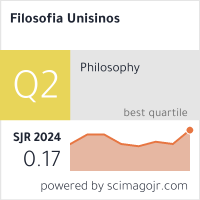Our deontological-utilitarian (deontoutilitarian) minds
DOI:
https://doi.org/10.4013/fsu.2013.142.03Abstract
In this article I discuss the standard responses given by people for moral dilemmas related to life and death, proposing a philosophical model that I call “the utilitarian-deontological (deontoutilitarian) model ” to explain how the majority of people respond to these dilemmas. I suggest that when people make moral judgements they use a system of judgments that combines utilitarian and deontological considerations, a system that is primarily deontological, and accept that to kill innocent people is wrong. Faced, however, with the necessity of having to kill someone to save more people, they will typically say that it is right to do this, unless they have to use their own personal force or have to have some kind of personal contact with the person(s) to be sacrificed. In these cases they will refrain from carrying out the act. However, typically they will agree that it is right to kill the person even using their personal force or having some kind of contact with the person if death is inevitable or in catastrophic situations, in which unless you kill one person hundreds of people will die as a consequence. The majority of us, however, will come back to their deontological judgment again if we are faced for example with a “blackmail” situation, in which someone asks us to carry out a killing and if we refuse they threaten to kill everybody. In this situation people are outraged with the offer and will typically judge the situation in a deontological way again, saying that it is wrong to carry out the killing.
Key words: trolley problems, moral dilemmas, deontoutilitarianism, utilitariandeontological model.
Downloads
Metrics
Downloads
Published
How to Cite
Issue
Section
License
I grant the Filosofia Unisinos – Unisinos Journal of Philosophy the first publication of my article, licensed under Creative Commons Attribution license 4.0 (which allows sharing of work, recognition of authorship and initial publication in this journal).
I confirm that my article is not being submitted to another publication and has not been published in its entirely on another journal. I take full responsibility for its originality and I will also claim responsibility for charges from claims by third parties concerning the authorship of the article.










